I am often asked when chicks can stop using a heat source and move from the brooder to the chicken coop. The short answer is…it depends. Many factors play a role in determining when the time is right to move chicks from the brooder to the chicken coop and we’ll take a look at them here. In the heat of summer, chicks may require supplemental heat for only a few weeks, in very cold weather, chicks may need supplemental heat for much longer.
I have learned more about chick comfort from observing mother hens with their chicks than I have from anything I have ever read. The first few days after hatching, chicks spend most of their time underneath the mother hen, venturing out occasionally to explore, eat and drink. When they get chilly, they simply return to the hen for warmth. Before long, they spend more time away from her than underneath her. My Silkie, Freida, often begins to distance herself completely from her chicks at approximately five weeks old. Six weeks is a good age to begin assessing whether chicks are ready to leave the brooder for the coop. The following factors also play a role in the determination.
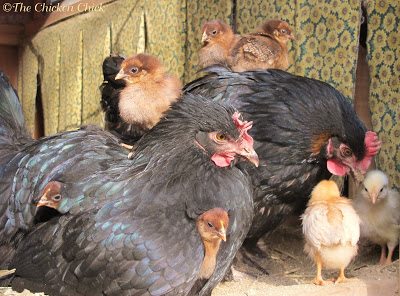
AGE/FEATHERING
In general, most chicks are fully-feathered by 6 weeks of age. That means that their chick down is gone and they have grown real feathers, which allow them to regulate their body temperatures. Not all breeds or individual chickens will be fully feathered at the same age, the actual feathering should be considered, not merely the age of the chick.

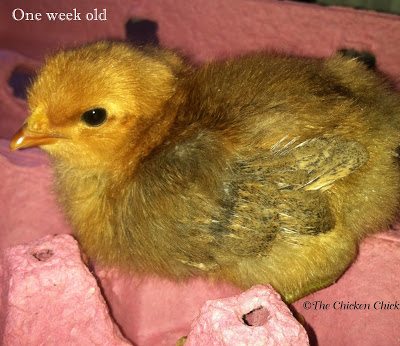
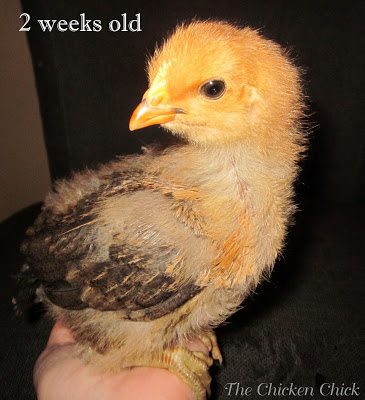
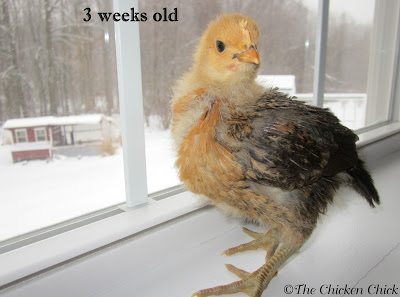
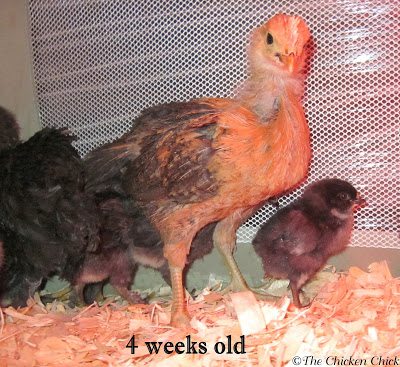

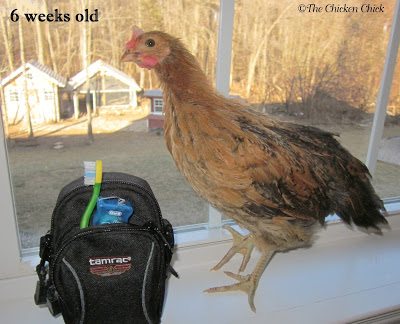
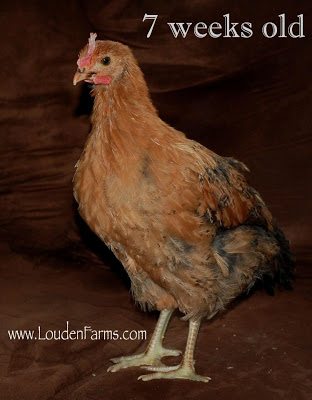
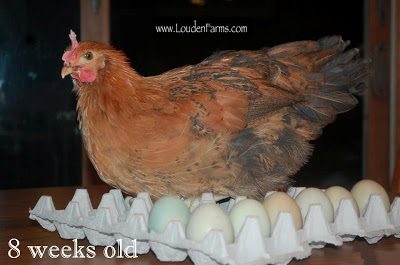
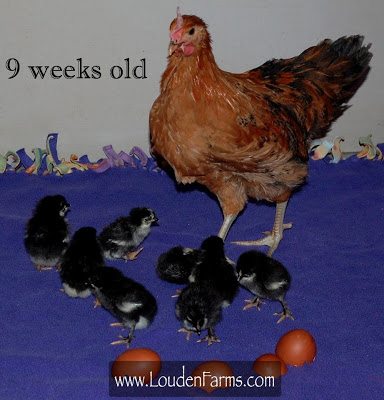
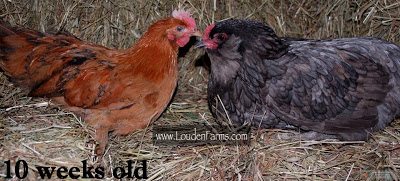
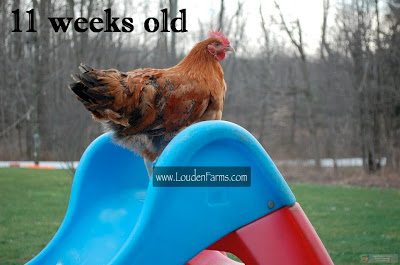
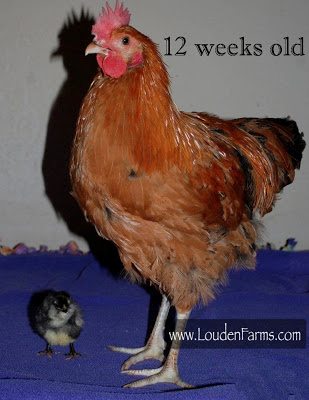
TEMPERATURES/TIME OF YEAR
“The Formula:” is what I call the usual temperature guidelines commonly suggested for day old chicks. The Formula holds that brooder temperatures should be kept between 90-95° F for the first week after hatching, and reduced by five degrees each week thereafter until the brooder temperature equals the ambient room temperature.
The Formula
Week 1= 90-95°F
Week 2= 85°F
Week 3= 80° F
Week 4= 75° F
Week 5= 70° F
Week 6=65°F
The Formula is a general guideline; the behavior of chicks is a much better indicator of their actual comfort level. The truth about The Formula is that while 90°F is critical in the first week, chicks do not need as much constant heat as heat lamps deliver for as long as it is ordinarily recommended. When chicks are observed spending very little time near the heat source, it can ordinarily be eliminated.
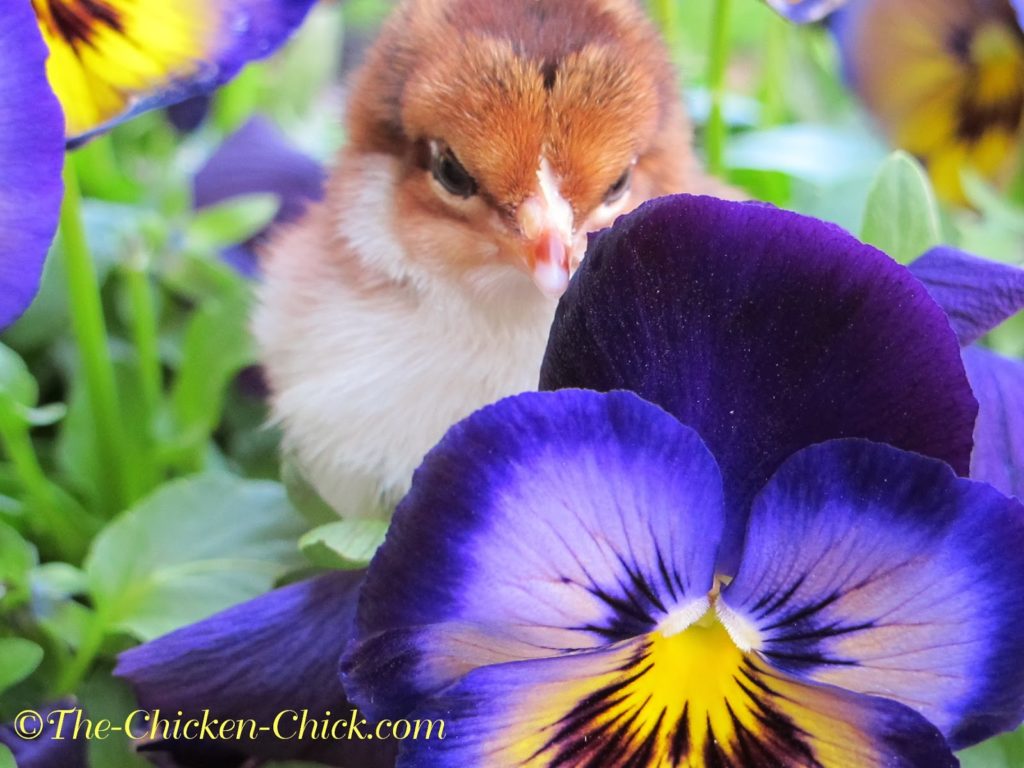
Ideally, chicks will not require a heat source when moving from brooder to coop. If the temperatures outside remain above 65°F and the chicks are at least 6 weeks old, they can move into the coop without supplemental heat. Watch and listen to the chickens. Noisy birds are unhappy, but there’s a difference between the sounds of a cold chick and a chick frightened by a new environment. Once teenage chickens become familiar with a new residence, they should be actively exploring, busily eating and scratching and contently quiet. If they’re huddled together and noisy, they’re probably cold.
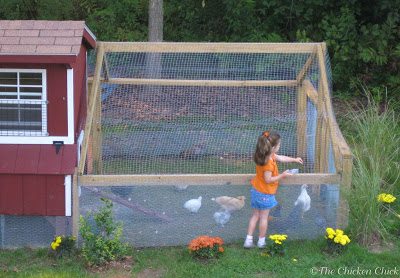
COOP CONSIDERATIONS
If a heat source is required, is there electricity to the coop and if so, can heat be safely supplied? If not, the move should wait until outside temperatures are warmer.
Is the coop predator proof? Chicks need to be protected from predators getting into the coop as well as from escaping from the safety of the coop themselves. Hardware cloth should be used to keep predators out and chicks in the coop.

NUMBER OF CHICKS
Each chick generates body heat and the more chicks there are, the better able they are to keep each other warm when necessary.
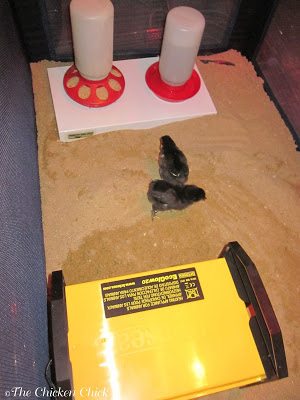
OLDER FLOCK MEMBERS
If older flock members are already living in the coop, it’s best to wait until the chicks are closer in size to the mature birds before beginning the process of integration into the flock. Smaller birds can be seriously hurt by normal pecking-order behavior from older, bigger birds.
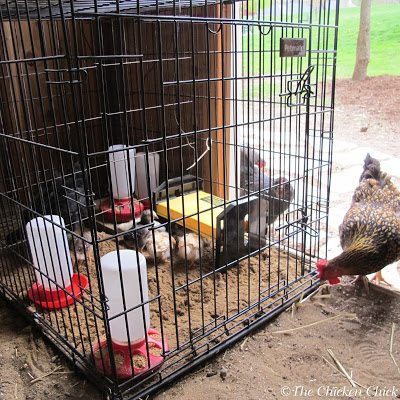
STRESS OF THE MOVE
Transition from one housing unit to another is extremely stressful for chickens of all ages. The behavioral problems that can result from this stress can be managed when knowing what to expect.
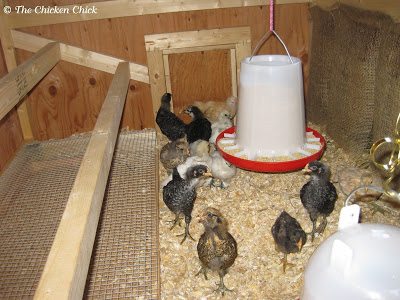
1. Instill the Concept of Home
When chicks are moved, they will be confused and will require time to acclimate to the coop. They need time to adjust to the idea that the coop is their permanent home and the place to which they should return at night. For this reason, I recommend keeping them inside the coop for several weeks prior to allowing them access to the run.
Chicks that are not given this initial time to decompress often fail to return to the safety of the coop at dusk independently, which can be frustrating for the chicken-keeper and dangerous for the birds. While it is possible to “coop train” older birds, it’s better to do it at the time of the big move.
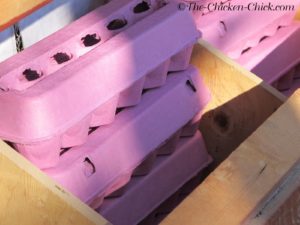
2. Deny Access to Nest Boxes
Upon arrival in the coop, the initial inclination of stressed chicks is to hide and nest boxes provide a natural refuge for scared chicks. Sleeping chickens are pooping chickens and while the habit of sleeping in nest boxes may not be a problem initially, when they begin egg-laying, it will be. Droppings soil freshly laid eggs and increase the risk of illness from their consumption even if they are washed. Blocking physical access to the nest boxes prior to the move prevents the chicks from getting into the habit of sleeping in them. Avoiding the behavior is much easier than trying to break the habit. By 17-18 weeks of age, the boxes can be opened for business.
If there are laying hens already living in the coop, close the nest boxes off (with cardboard, plywood, etc.) in the afternoon after egg-laying is finished for the day and open them back up first thing in the morning. This allow the layers access to the boxes during the day and prevents slumber parties in the nest boxes at night.
Kathy Shea Mormino
Affectionately known internationally as The Chicken Chick®, Kathy Shea Mormino shares a fun-loving, informative style to raising backyard chickens. …Read on


shop my SPONSORS
I am often asked when chicks can stop using a heat source and move from the brooder to the chicken coop. The short answer is…it depends. Many factors play a role in determining when the time is right to move chicks from the brooder to the chicken coop and we’ll take a look at them here. In the heat of summer, chicks may require supplemental heat for only a few weeks, in very cold weather, chicks may need supplemental heat for much longer.
I have learned more about chick comfort from observing mother hens with their chicks than I have from anything I have ever read. The first few days after hatching, chicks spend most of their time underneath the mother hen, venturing out occasionally to explore, eat and drink. When they get chilly, they simply return to the hen for warmth. Before long, they spend more time away from her than underneath her. My Silkie, Freida, often begins to distance herself completely from her chicks at approximately five weeks old. Six weeks is a good age to begin assessing whether chicks are ready to leave the brooder for the coop. The following factors also play a role in the determination.

AGE/FEATHERING
In general, most chicks are fully-feathered by 6 weeks of age. That means that their chick down is gone and they have grown real feathers, which allow them to regulate their body temperatures. Not all breeds or individual chickens will be fully feathered at the same age, the actual feathering should be considered, not merely the age of the chick.













TEMPERATURES/TIME OF YEAR
“The Formula:” is what I call the usual temperature guidelines commonly suggested for day old chicks. The Formula holds that brooder temperatures should be kept between 90-95° F for the first week after hatching, and reduced by five degrees each week thereafter until the brooder temperature equals the ambient room temperature.
The Formula
Week 1= 90-95°F
Week 2= 85°F
Week 3= 80° F
Week 4= 75° F
Week 5= 70° F
Week 6=65°F
The Formula is a general guideline; the behavior of chicks is a much better indicator of their actual comfort level. The truth about The Formula is that while 90°F is critical in the first week, chicks do not need as much constant heat as heat lamps deliver for as long as it is ordinarily recommended. When chicks are observed spending very little time near the heat source, it can ordinarily be eliminated.

Ideally, chicks will not require a heat source when moving from brooder to coop. If the temperatures outside remain above 65°F and the chicks are at least 6 weeks old, they can move into the coop without supplemental heat. Watch and listen to the chickens. Noisy birds are unhappy, but there’s a difference between the sounds of a cold chick and a chick frightened by a new environment. Once teenage chickens become familiar with a new residence, they should be actively exploring, busily eating and scratching and contently quiet. If they’re huddled together and noisy, they’re probably cold.

COOP CONSIDERATIONS
If a heat source is required, is there electricity to the coop and if so, can heat be safely supplied? If not, the move should wait until outside temperatures are warmer.
Is the coop predator proof? Chicks need to be protected from predators getting into the coop as well as from escaping from the safety of the coop themselves. Hardware cloth should be used to keep predators out and chicks in the coop.

NUMBER OF CHICKS
Each chick generates body heat and the more chicks there are, the better able they are to keep each other warm when necessary.

OLDER FLOCK MEMBERS
If older flock members are already living in the coop, it’s best to wait until the chicks are closer in size to the mature birds before beginning the process of integration into the flock. Smaller birds can be seriously hurt by normal pecking-order behavior from older, bigger birds.

STRESS OF THE MOVE
Transition from one housing unit to another is extremely stressful for chickens of all ages. The behavioral problems that can result from this stress can be managed when knowing what to expect.

1. Instill the Concept of Home
When chicks are moved, they will be confused and will require time to acclimate to the coop. They need time to adjust to the idea that the coop is their permanent home and the place to which they should return at night. For this reason, I recommend keeping them inside the coop for several weeks prior to allowing them access to the run.
Chicks that are not given this initial time to decompress often fail to return to the safety of the coop at dusk independently, which can be frustrating for the chicken-keeper and dangerous for the birds. While it is possible to “coop train” older birds, it’s better to do it at the time of the big move.

2. Deny Access to Nest Boxes
Upon arrival in the coop, the initial inclination of stressed chicks is to hide and nest boxes provide a natural refuge for scared chicks. Sleeping chickens are pooping chickens and while the habit of sleeping in nest boxes may not be a problem initially, when they begin egg-laying, it will be. Droppings soil freshly laid eggs and increase the risk of illness from their consumption even if they are washed. Blocking physical access to the nest boxes prior to the move prevents the chicks from getting into the habit of sleeping in them. Avoiding the behavior is much easier than trying to break the habit. By 17-18 weeks of age, the boxes can be opened for business.
If there are laying hens already living in the coop, close the nest boxes off (with cardboard, plywood, etc.) in the afternoon after egg-laying is finished for the day and open them back up first thing in the morning. This allow the layers access to the boxes during the day and prevents slumber parties in the nest boxes at night.




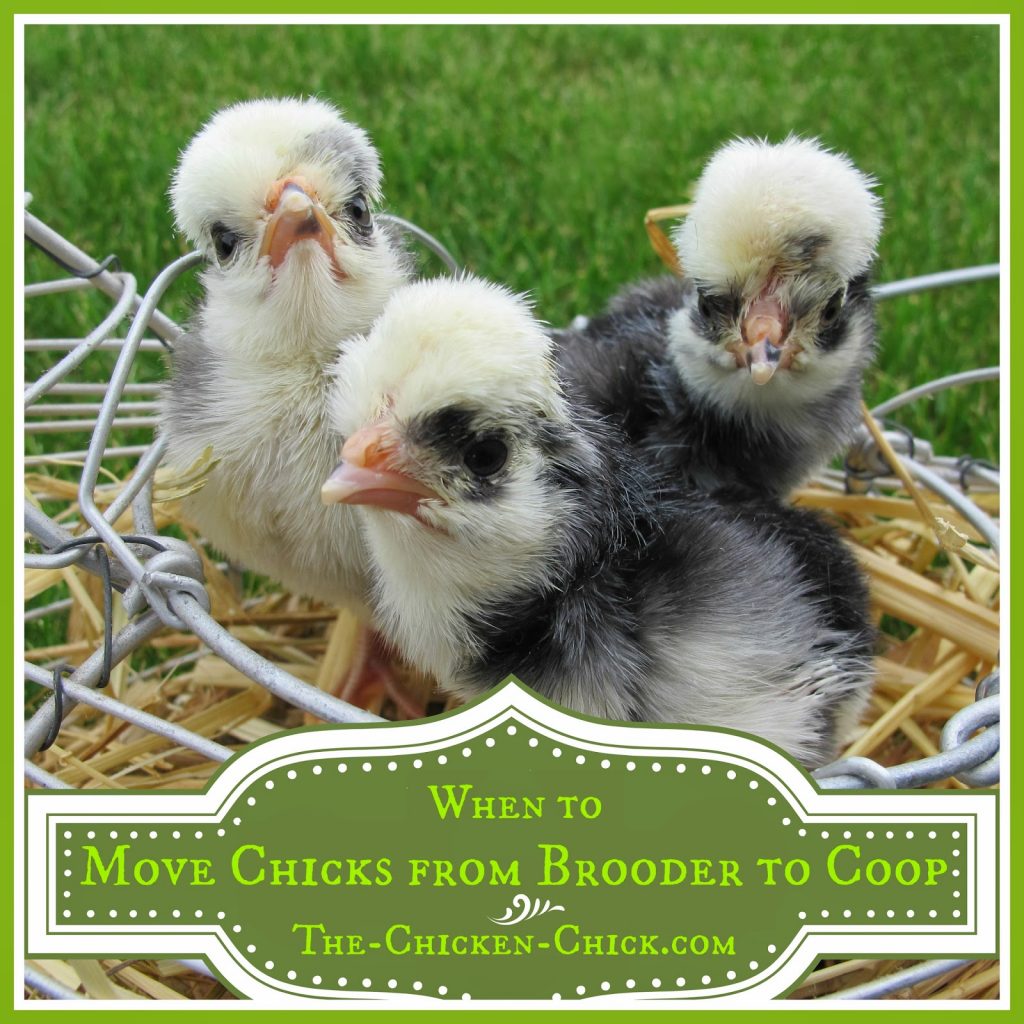
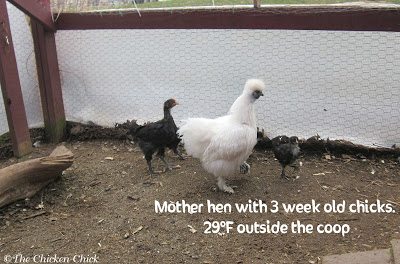

















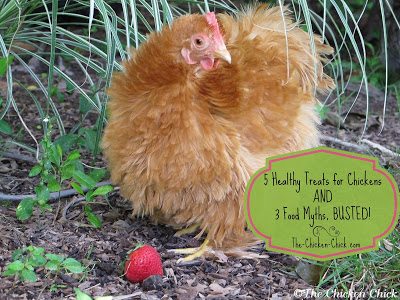

















When can I allow my baby chicks to play outside for a short period?
When it’s warm enough for their age and they’re supervised in a predator-proof setting.
We have our first chook pen and five chickens. They are about 6 weeks old. We live in the tropics (Darwin). I’m not sure when we can move them into the hen house?
This should help, Cathy: https://the-chicken-chick.com/when-to-move-chicks-from-brooder-to/
We’re expecting our first (ever) chickens this coming week – it’s very hot here in New England. Possibly too hot to keep the chicks closed into their coop once they’re big enough to move outside. I wonder if I should move their brooder into the coop to begin with so they get used to it from the beginning, then they can enjoy the run when they’re bigger and not have to be cooped up?
It’s cooler this week. I think you should keep them in the house so you can monitor them closely for several weeks.
Thank you! They’re doing well and I feel prepared for all sorts thanks to your many helpful articles. Really appreciate it!
We are building a new barn and part of it will be a new coop. Right now I have four adult hens and three chicks (not out of the brooder yet). Would it be better to introduce both the adults and the chicks to the new coop at the same time or should I introduce one before the other?
I suggest beginning the introductions before the move to the coop.
I have your book but I am still questioning when to move my chicks out to the coop. They are 7 weeks old still in the brooder under a heat lamp in garage. Temp. here in NC 65 during the day and 40’s at night. Our coop does not have heat source, I am thinking take the heat lamp away this week and see how they do in brooder in garage the rest of this week? Help, my husband says it is time I just don’t know…..
They do not need a heat lamp at 7 weeks old inside a garage. I would probably wait until the low temps are at or above 50 before moving them outside.